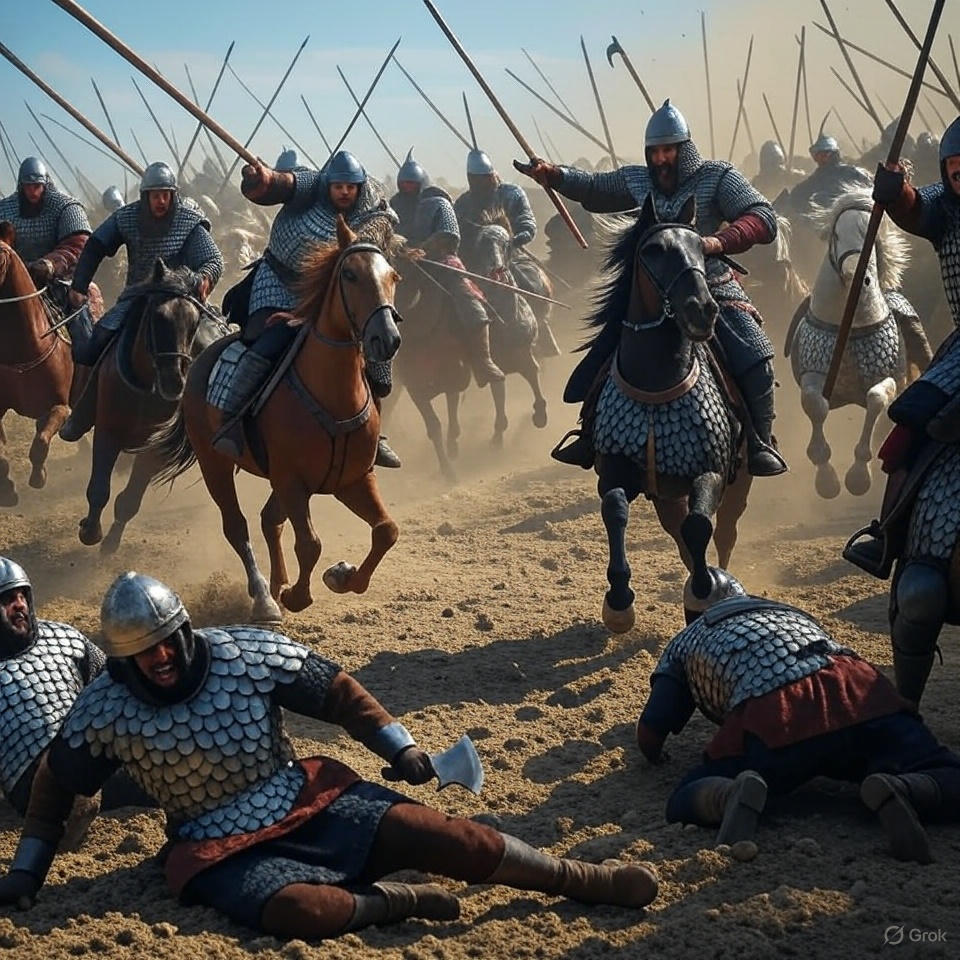Imagine a sun-drenched Black Sea coast, where the lazy flow of a river belies the carnage about to unfold. On August 20, 917 AD, the Achelous River—now a quiet stream near modern-day Pomorie in Bulgaria—became the stage for one of the most brutal and decisive battles of the Middle Ages. This wasn’t just a clash of swords and shields; it was a pivotal moment that reshaped the map of Eastern Europe, elevated a burgeoning kingdom to imperial status, and sent shockwaves through the mighty Byzantine Empire. The Battle of Achelous, often overshadowed by more famous conflicts like the Crusades or the fall of Constantinople, stands as a testament to strategic brilliance, raw ambition, and the unforgiving nature of medieval warfare. In this deep dive, we’ll unearth the layers of history surrounding this epic confrontation, exploring its roots in centuries-old rivalries, the intricate prelude of diplomatic maneuvering, the chaotic fury of the battle itself, and the far-reaching aftermath that solidified Bulgaria’s golden age. And while the historical saga takes center stage—packed with vivid details drawn from ancient chronicles like those of Leo the Deacon and John Skylitzes—we’ll cap it off with motivational insights on how the lessons from this distant clash can supercharge your personal life today, turning everyday challenges into triumphs.
To set the scene visually, here’s where our ultra-realistic images fit in seamlessly to bring the story to life. Each is conceptualized as a 150×150 pixel square, hyper-detailed rendering that feels like a window into the past—think photorealistic textures, accurate historical attire, and atmospheric lighting for maximum immersion:

The Byzantine Empire in the early 10th century was a colossus straddling Europe and Asia, heir to the Roman legacy with its glittering capital of Constantinople as the envy of the world. Ruled by a succession of emperors from the Macedonian dynasty, it boasted advanced administration, a professional army known as the tagmata, and a navy that dominated the Mediterranean. Yet, beneath the veneer of invincibility lurked vulnerabilities: constant threats from Arab caliphates in the east, internal court intrigues, and restless neighbors in the Balkans. Enter Bulgaria, a Slavic-Bulgar state that had evolved from nomadic origins into a formidable power under the Dulo dynasty and later the Krumids. By the 9th century, Bulgaria had adopted Christianity in 864 under Tsar Boris I, blending pagan traditions with Orthodox rites, and expanded its territories through savvy alliances and ruthless campaigns.
The seeds of the 917 battle were sown decades earlier. In 894, Tsar Simeon I—educated in Constantinople and fluent in Greek—launched a war against Byzantium over trade disputes, culminating in the Battle of Bulgarophygon in 896, where Bulgarian forces crushed the Byzantines. The ensuing peace treaty forced Byzantium to pay annual tribute to Bulgaria, acknowledging Simeon’s growing influence. Simeon, often called “the Great,” was no mere warrior; he was a scholar-king who fostered a cultural renaissance, promoting Slavic literacy through the works of saints Cyril and Methodius’ disciples. His court at Preslav became a hub of art, architecture, and theology, with golden-domed churches rivaling those in Byzantium. But Simeon’s ambitions soared higher—he dreamed of wearing the imperial purple, uniting the Bulgarian and Byzantine crowns under his rule.
Tensions reignited in 912 with the death of Emperor Leo VI. His brother Alexander, a short-lived ruler known for his debauchery, halted the tribute payments, viewing them as humiliating. Simeon responded with invasions into Thrace, the fertile region southeast of Bulgaria. Alexander’s death in 913 left the empire in the hands of a regency council for the young Constantine VII, headed by Patriarch Nicholas Mystikos. Desperate to avert war, Nicholas negotiated a truce, culminating in a bizarre ceremony outside Constantinople’s walls where Simeon was “crowned” with a patriarchal diadem—not the imperial crown he craved—and promised a marriage between Constantine and Simeon’s daughter. Simeon seized this as legitimacy, styling himself “Tsar (Caesar) of the Bulgarians and Romans” in his seals and correspondence, a bold claim that infuriated Byzantine elites.
But palace politics shifted dramatically in 914 when Empress Zoe Karbonopsina, Constantine’s mother, ousted Nicholas and annulled the marriage pact. Zoe, a strong-willed figure who had risen from concubine to empress, prioritized Byzantine purity over alliances with “barbarians.” Simeon, feeling betrayed, unleashed raids that sacked Adrianople (modern Edirne), where locals briefly hailed him as ruler. By 915, Bulgarian forces probed as far as Thessalonica and Dyrrhachium (Durrës), disrupting Byzantine trade routes. The empire, stretched thin by Arab incursions in Anatolia, faced a multi-front crisis. Chronicles describe Simeon’s armies as disciplined blends of heavy cavalry—armored in chainmail and lamellar plates—and infantry wielding spears, axes, and the fearsome Slavic bows. Bulgarian tactics emphasized mobility, drawing from steppe heritage, while Byzantines relied on phalanx-like formations and Greek fire.
As 917 dawned, both sides geared for Armageddon. Zoe, having secured a fragile peace with the Abbasid Caliphate, redirected eastern legions westward. Byzantine envoys fanned out to potential allies: the nomadic Pechenegs on the steppes, the Magyars (early Hungarians) in the Pannonian Basin, and the Serb principalities under Prince Petar Gojniković. Gold flowed freely to buy loyalties, with promises of land and titles. Simeon, a master diplomat schooled in Byzantine intrigue, countered effectively. He dispatched spies and bribes, sowing discord among the Pechenegs and reminding the Serbs of past Bulgarian aid against Byzantine encroachments. Hungarian sources, like the Gesta Hungarorum, hint at covert Bulgarian overtures, though evidence is debated.
The Byzantine army swelled to an estimated 60,000 men—a colossal force for the era—including theme troops from Asia Minor, elite Varangian Guards (Viking mercenaries), and Armenian auxiliaries. Command fell to Domestic of the Schools Leo Phocas, a veteran aristocrat with a reputation for tactical acumen but plagued by court rivals. Morale boosters included religious rituals; soldiers swore oaths on relics of the True Cross, vowing mutual sacrifice. A fleet under Drungarios Romanus Lecapenus—future emperor—sailed to the Danube delta to ferry Pecheneg hordes across for a pincer attack on Bulgaria. Yet, Romanus, sensing political opportunity, sabotaged the plan by refusing transport, claiming logistical issues. The Pechenegs, frustrated, raided Bulgarian lands independently but achieved little.
Simeon, meanwhile, mustered his core forces, likely 20,000-30,000 strong, though exact numbers remain elusive in sources like Theophanes Continuatus. He detached contingents under Marmais to guard western frontiers against Serb unrest and small garrisons to watch the northern steppes. Some historians, citing the Miracula Sancti Georgii, argue for Hungarian and Pecheneg allies on Bulgaria’s side, but Patriarch Nicholas’s letters suggest otherwise, portraying the nomads as Byzantine pawns. Simeon’s strategy hinged on unity: unlike the fractured Byzantines, his command was centralized, his troops motivated by national pride and the promise of plunder.
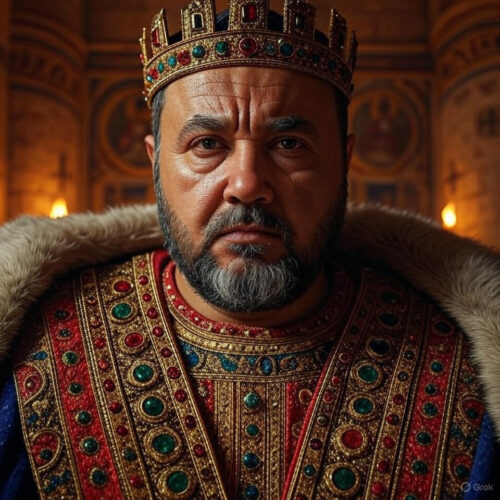
The armies converged near Anchialus, a fortified port on the Black Sea. Leo Phocas advanced north from Constantinople, camping by the Achelous River, a modest waterway feeding into the sea. His plan: invade Moesia (northern Bulgaria), link with Pechenegs, and crush Simeon in a vise. Simeon, anticipating this, massed on elevated terrain south of the river, using the landscape for ambush potential. Scouts reported Byzantine movements, allowing Simeon to position his wings strongly—cavalry-heavy flanks—with a thinner center to bait the enemy.
Dawn broke on August 20, 917, with the air thick from summer heat and the scent of salt. Byzantine trumpets blared as Leo Phocas ordered a general assault. His forces, arrayed in deep ranks, charged the Bulgarian center. Initial clashes favored the Byzantines: their armored cataphracts smashed through, inflicting heavy casualties. Bulgarian lines buckled, retreating northward in seeming disarray. Elated, Byzantine troops pursued, shouting victory cries. Discipline frayed as rumors spread—falsely—that Phocas had fallen. Units fragmented, looting abandoned camps instead of maintaining formation.
This was Simeon’s trap. From hidden reserves behind the hills, he unleashed his elite cavalry in a thunderous countercharge. Bulgarian horsemen, clad in scale armor and wielding lances, slammed into the disorganized Byzantine flanks. Panic rippled through the imperial ranks. What began as a rout turned into slaughter. Chronicles recount rivers of blood staining the Achelous red, bodies piling so high that horses stumbled. Leo Phocas, unhorsed but alive, fled on foot to a nearby fortress, then by boat to Constantinople. His second-in-command, Constantine Lips, perished alongside dozens of high-ranking officers—68 aristocrats in total, per Leo the Deacon, a loss akin to wiping out an entire noble class.
The carnage was apocalyptic. Byzantine sources lament 60,000 dead, though exaggerated; realistic estimates peg 20,000-30,000 casualties. Bulgarians pursued relentlessly, cutting down fugitives in marshes and woods. Nightfall brought another clash at Katasyrtai, where Phocas’s remnants were ambushed and shattered anew. Simeon, merciful in victory? Hardly—chronicles note his troops beheading captives, a grim trophy tradition.
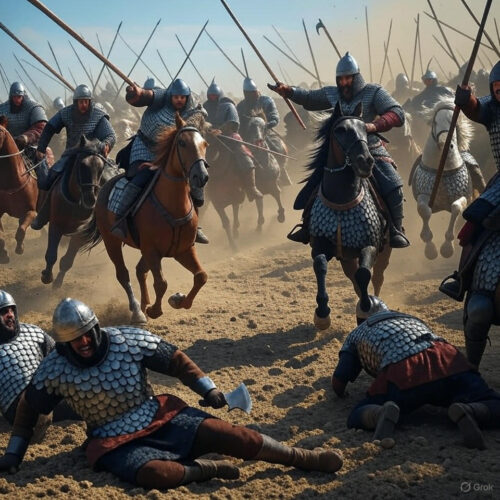
The aftermath rippled across empires. Simeon pressed southward, ravaging Thrace and besieging Constantinople by 918. Lacking a navy, he couldn’t breach the Theodosian Walls, but his dominance was unchallenged. In 919, Romanus Lecapenus seized the Byzantine throne, marrying his daughter to Constantine VII and stabilizing the regime. Yet, he sued for peace, recognizing Simeon’s imperial title in 927—the first non-Byzantine ruler so honored. Bulgaria reached its zenith: territories spanned from the Adriatic to the Black Sea, encompassing modern Bulgaria, Romania, Macedonia, and parts of Serbia and Greece. Culturally, the “Golden Age” flourished with literature in Old Bulgarian, monumental architecture like the Round Church in Preslav, and missionary zeal spreading Slavic Christianity.
For Byzantium, the defeat was humiliating, exposing military weaknesses and accelerating reforms under later emperors like Basil II. The battle’s scale—dubbed the bloodiest in medieval Europe by some—underscored the shift from Roman invincibility to a multipolar Balkans. Historians like Vasil Zlatarski and John Haldon analyze it as a masterclass in feigned retreat, akin to Hannibal’s tactics at Cannae. Archaeological digs near Pomorie have unearthed arrowheads, sword fragments, and mass graves, corroborating the slaughter’s extent.
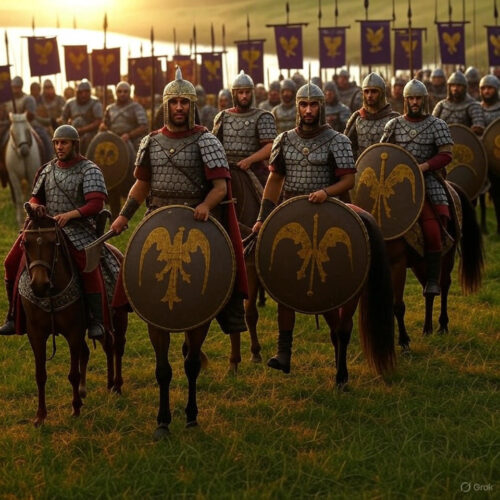
Shifting gears to the empire’s long shadow, the Battle of Achelous wasn’t just a footnote in dusty tomes; it offers profound lessons for today. The outcome—a stunning underdog victory against overwhelming odds—highlights themes of strategic patience, adaptability, and unyielding ambition. Simeon turned potential disaster into dominance, much like how you can pivot personal setbacks into successes. Here’s how this historical fact benefits you individually, applied to modern life with specific, actionable insights.
First, the bullet points on personal benefits:
– **Cultivate Strategic Patience in Career Challenges**: Just as Simeon waited for the perfect moment to counterattack, delay impulsive reactions to workplace setbacks like a denied promotion. Instead, gather “intelligence” by networking and upskilling, turning the tide in your favor over months rather than days.
– **Embrace Feigned Retreats for Relationship Resilience**: Simeon’s tactical withdrawal lured enemies into vulnerability; similarly, in conflicts with friends or partners, step back temporarily to reflect, allowing emotions to cool and revealing the other’s true intentions for a stronger reconciliation.
– **Build Hidden Reserves for Financial Security**: The Bulgarian cavalry hidden in hills mirrors saving an emergency fund or investing in side hustles discreetly, so when economic “battles” like job loss strike, you launch a comeback without desperation.
– **Foster Alliances to Overcome Isolation**: Simeon neutralized Byzantine diplomacy; in your life, proactively build a support network—mentors, peers, family—before crises, ensuring you’re not fighting alone during health scares or personal lows.
– **Claim Your “Imperial Title” in Self-Confidence**: Post-victory, Simeon asserted his tsardom; apply this by celebrating small wins publicly, like updating your LinkedIn after a project success, to build momentum and command respect in professional circles.
Now, a step-by-step plan to integrate these lessons into your daily routine:
- **Week 1: Historical Immersion and Reflection** – Spend 15 minutes daily reading about underdog victories (start with Achelous via online resources). Journal one current challenge and brainstorm a “feigned retreat” strategy, like pausing a heated argument to gather thoughts.
- **Week 2: Build Your Reserves** – Audit your skills and finances; dedicate time to learn a new tool (e.g., a coding course if in tech) and set aside 10% of income for an “ambush fund.” Track progress in a dedicated app.
- **Week 3: Diplomatic Maneuvering** – Reach out to three contacts weekly for coffee chats or advice sessions, mirroring Simeon’s alliance-building. Note how these strengthen your network against future “invasions” like career shifts.
- **Week 4: Counterattack Execution** – Apply patience in one real scenario, such as negotiating a raise by waiting for the right moment post-company success. Celebrate with a personal ritual, affirming your growth.
- **Ongoing: Motivational Maintenance** – Monthly, revisit the battle’s story for inspiration, adjusting your plan as life evolves. Visualize your “victory march” to Constantinople—your ultimate goal, be it a dream job or personal milestone.
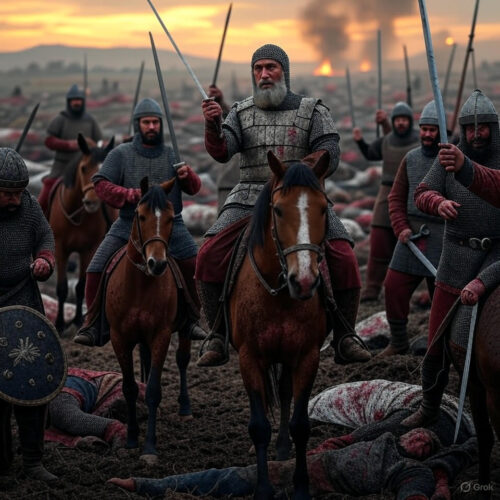
This blend of history and motivation shows how events from over a millennium ago still pulse with relevance. The Battle of Achelous reminds us that history isn’t static—it’s a playbook for perseverance. Dive into your own “battles” with Simeon’s spirit, and watch empires rise in your life.

